________________
Today due to the advent of technology and Knowledge industry, the world is becoming a Global village with open borders. We hear the cry from all corners of the world for a harmonious, peaceful and non violent NEW ORDER for co existence amongst various religions and nations.
1.4
Current situation
In the twentieth century we saw a number of countries getting independence from their colonial rulers. The local governments had to learn to rule, affect economic and social development for their subjects and ensure religious harmony amongst their subjects. We also saw partitions based on religion (India Pakistan), and even states within India. Even though India was divided according to religion, still India opted for a secular constitution. A number of developed countries opted for a secular constitution while a number of under developed countries moved to the extreme religion based constitution as well. Major religion group tried to be bold and set up their own religious political entities wielding influence. Intelligentsia on the other hand tried to organize Inter faith groups. However my own experience of some of the Inter faith groups is different than what is intended. The interests of the main religious system spearheading a particular group are promoted by inducting members of different religions and so could not make much progress. Examples are the efforts of Dalai Lama, the MillionMarch in Washington in March 2010 (Farrakhan called for black Muslim in US to unite for a separate black USA. Dan Fefferman of Unification Church of US not agreeing and asking for a God centred family, interracial harmony, inter religious unity and moral revival) etc and a large number of inter faith groups all over the world. The result is for all of us to see.
Where do we go to succeed in developing harmony (and not unity) amongst religions? In this paper I propose agreeing to certain basic values (non violence, multiplicity of viewpoints and limiting possessions) for adoption, practice and to live by them. Each person is free to practice the religion of his choice without any coercion or superstition.
2.
Jain canons define religion as follows:
Jain doctrine ahinsa, anekanta, aparigraha
Dhammo mangala mukkhitam ahinsa sanjamo tavo Deva vi tam namasanti jassa dhamme saya mane
i.e. that which is non-violence, self restraint and austerity is Dharma (spiritual values). It is by virtue of spiritual values that supreme beneficence results. To him whose mind is absorbed in spiritual values even gods pay homage. Here we say non violence and its method to be so i.e. self restraint or awareness to be careful in causing harm to any living being including the oneself also and finally austerities to achieve the highest goal i.e. bliss is the religion.
Later on Jain preceptors stated defining religions from many different aspects as indicated below:
Dhammo vatthu sahavo khamadi-bhavo ya das viho dhammo Rayanattayam ca dhammo jivanam rakkhanam dhammo
i.e. Nature of an entity is its religion, forgiveness etc tenfold virtues is religion, Right belief-knowledge-conduct is religion and protecting the living beings is religions.
Thus philosophically Jains talk of the nature of an entity as its religion. Further they say that the nature of all living beings is to be happy and stay in a state of bliss forever. To enjoy one's nature, the path is also said as the religion which consists of ten virtues (forgiveness, humility, straightforwardness, truthfulness, cleanliness, giving up, penance, detachment and stay in one's own nature or celibacy) and to achieve bliss it consists of right belief-knowledge-conduct together. Protecting the lives of all living beings is also said to be the religion. The Jain slogans 'Live and let live' and 'Living beings cooperate with each other' present the Jain doctrine and its practice to common followers.
From the above two statements, we can see that Jains put lot of emphasis on effort to improve oneself as well as the karma doctrine i.e. as you sow, so shall you reap. These definitions give way to the three cardinal principles of Jain way of life (or engagement as indicated above), namely:"
1. Ahinsa or non violence in conduct
2. Aparigraha or Non-possession in life and society
3. Anekanta or multiplicity of viewpoints in thoughts
Page 471 of 556
STUDY NOTES version 4.0




